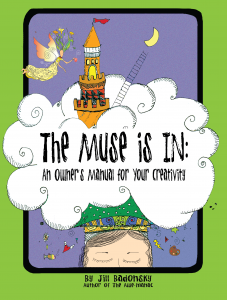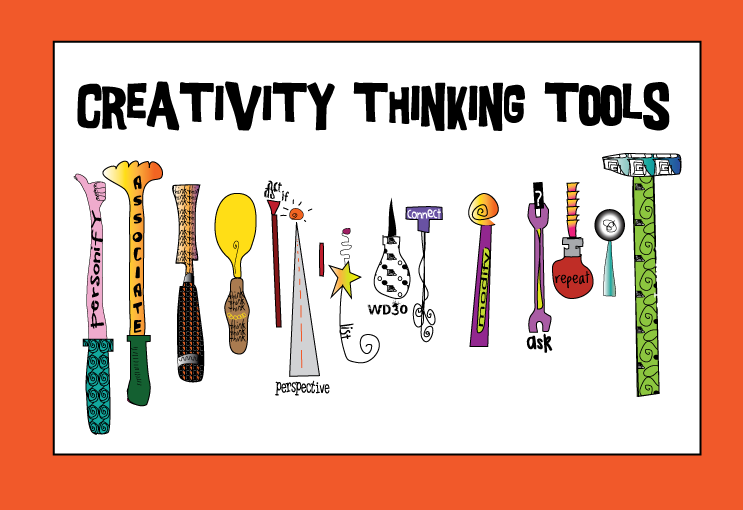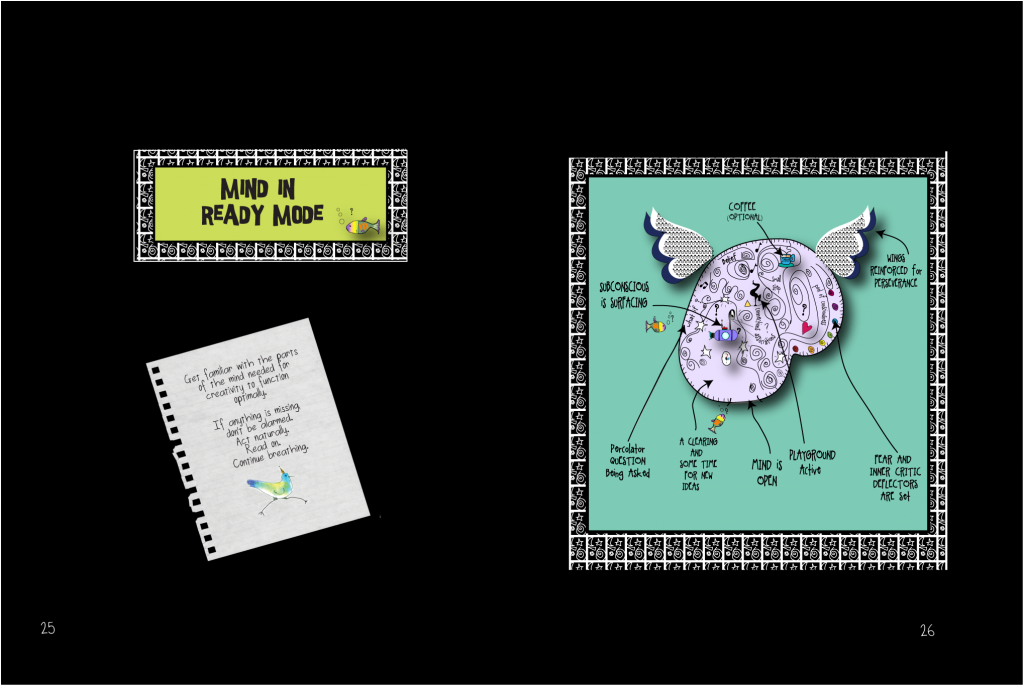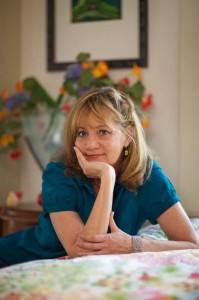Our last post featured part one of a two-part Q&A session with JIll Badonsky, whose most recent book, The Muse Is In: An Owner’s Manual to Your Creativity, has just been released. Following is the second part of the interview in which we get into some of the nuts and bolts of Jill’s book and her views on creativity and having fun. Hope you have fun reading it.
 I love the Creativity Quiz in your book. You ask: “Are you breathing?” I don’t have a question here, I just wanted to say how much I like this question because the answer for all of us is so obvious. You’re saying if we’re alive and breathing, we’re creative.
I love the Creativity Quiz in your book. You ask: “Are you breathing?” I don’t have a question here, I just wanted to say how much I like this question because the answer for all of us is so obvious. You’re saying if we’re alive and breathing, we’re creative.
Thanks for acknowledging the quiz. I truly believe people are less alive both when they are not breathing and when they don’t allow themselves to engage in a creativity because they have a preconceived notion of what it’s supposed to be, how good it is supposed to be, how they are supposed to do it, and what they are supposed to do with. Creative is so much more. It’s a way of living and seeing. It just isn’t always easy so we have to be willing to get past the difficulties to its sublimity.
In your book you list as “Creativity Starters” loneliness, free-floating anxiety, and angst, among many other things, like hammers, a cactus and duct tape. How can what we think of as negative emotional states be the start of creativity?
Thank goodness for creativity when it comes to the hard parts of being alive. Difficult emotions are where many works of poetry, art, music, theater, film and dance come from. Works of genius are also works of sublimation, healing, and connecting us to with the whole spectrum of experiences we have as humans . When we alchemize emotion into art, we take energy that would normally drag us down, and elevate it into art. When we do this we liberate and heal ourselves as well as provide that possibility for all who come in contact with what we share.
The book is subtitled, An Owner’s Manual to Your Creativity and is divided into sections with the front section devoted to tools for discovering our own creativity such as Optimal State of Mind, Gizmos to Power Up Your Creativity, Creativity Thinking Tools and Troubleshooting. This last section lists such things as resistance and rebellion, fear, perfectionism, procrastination and so on. What would you say gets in the way of most people expressing their creativity or living a creative life?

Right now what gets in people’s way is a conglomeration of different dynamics related to fear and overwhelm. Fear leads to procrastination and overwhelm which leads to avoidance. Many people are unaware that creativity inherently brings up: fear of not being good enough, of witnessing our own ineptness, of expectation, of giving up comfortable habit. Fear doesn’t feel very fun, so we tend to avoid it by showing up for those things that don’t trigger fear like social media, TV, and computer games. We repeat these detours so many times that they become comfortable habits. And we underestimate how difficult it is to break a habit.
TV and Internet have shortened our attention spans and trained them to hop by one thing to another without going to the depth required in the creative process. We need to vigilantly follow an idea through all its stages, take it deep, revise it, open it up and complete it. The ability to do this is being compromised by our current states of consciousness which needs to be seriously addressed for those who desire the rewards of the creative process. It starts by using small steps and small increments of time to shift habits.
The second part of the book, a “Day-to-Day Maintenance Datebook” includes
what, a bzillion creativity spark ideas? At least one for every day of the year, sometimes more. Do you have a garden where you grow these things? Where do you get your creative ideas?
I have a laboratory where ideas are incubated from the mold in my refrigerator combined with belly button lint and an mischievous attitude. And when that doesn’t work I get ideas for my prompts mostly through free-associating sometimes with the inspiration from people who were born on each day, or just by letting my silly inventiveness run wild. This was one of the favorite parts of writing the book because free-associating is not only a blast to do but it’s one of the things I do best.

You’re a creativity coach, too. And you also have a program to train other creativity coaches. What does a creativity coach do?
There are different schools of creativity coaching so I’m just speaking for the Kaizen-Muse Creativity Coaching Training Program. We work with anyone who is experiencing procrastination, overwhelm, self-sabotage, perfectionism, difficulty focusing and starting, and any other obstacle to their creative process of life goals. We use a set formula of questions that work, intuitively designed questions, play, compassion, creative tools and experiences, and small steps to help them move beyond what’s keeping them stuck.
I love to make messy art and play with textures and colors, but, really, I don’t have the talent to be a visual artist. What’s the difference between being creative and being talented?
Creativity is a talent and a skill. Some people are inherently born with more talent or willingness than others but everyone gets better with practice. You would get more creative with textures and colors if you had the willingness, the instruction, the tools of and gave yourself lots of time to practice. Judy, two of your natural creative talents are writing and teaching, but if your passion were textures and colors, you could find a way to be creative at those at well. It sounds like you are satisfied with just experiencing them with no expectations… that to me is called having fun.
Your book is so witty, clever, sometimes silly and so much fun, as well as being very practical and inspiring, but tell us Jill, do you just go through life having fun?
Thank you for those kind words, Judy. Yes, I do mostly have fun except around tax time and driving through L.A.; fun is one of creativity’s gifts to me.
Anything else you’d like to say, any thoughts to leave us with?
You ask hard questions Judy. Thanks, I needed some hard ones. Thank you so much for this interview. I love your writing and your classes. I’ve always admired your work.
Me, too, you, Jill. I’m one of your biggest fans. Thanks for creating this book, and for all you do.
 Jill Badonsky, M.Ed., is an internationally recognized workshop leader, keynote speaker, creativity-coaching pioneer, illustrator, and humorist. As the founder and director of Kaizen-Muse Creativity Coaching, she consults with filmmakers, comedians, artists, writers, business leaders, and anyone who is experiencing procrastination and other blocks to positive changes. Jill’s other books are The Awe-Manac, and The Nine Modern Day Muses (and a Bodyguard). Visit her at themuseisin.com where you can play a little tune as you explore all the wonders she has to offer.
Jill Badonsky, M.Ed., is an internationally recognized workshop leader, keynote speaker, creativity-coaching pioneer, illustrator, and humorist. As the founder and director of Kaizen-Muse Creativity Coaching, she consults with filmmakers, comedians, artists, writers, business leaders, and anyone who is experiencing procrastination and other blocks to positive changes. Jill’s other books are The Awe-Manac, and The Nine Modern Day Muses (and a Bodyguard). Visit her at themuseisin.com where you can play a little tune as you explore all the wonders she has to offer.
To read Part One of our interview with JIll, click here.
